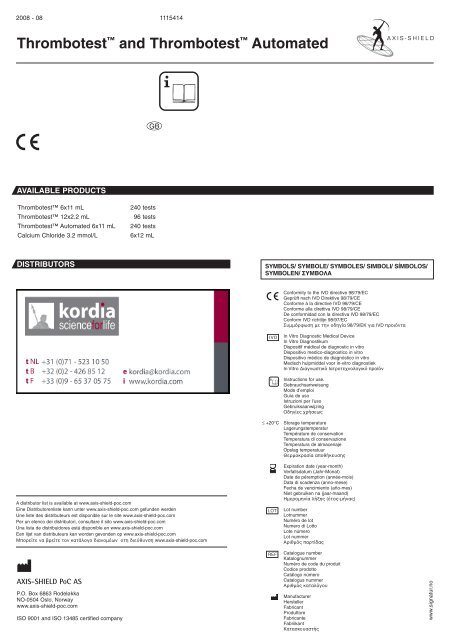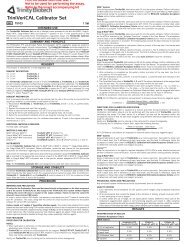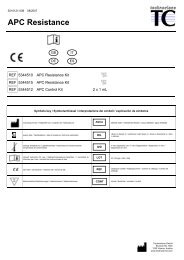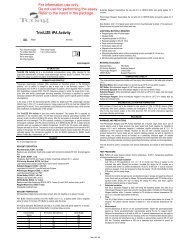Thrombotest™ and Thrombotest ™ Automated - Stago BNL
Thrombotest™ and Thrombotest ™ Automated - Stago BNL
Thrombotest™ and Thrombotest ™ Automated - Stago BNL
You also want an ePaper? Increase the reach of your titles
YUMPU automatically turns print PDFs into web optimized ePapers that Google loves.
2008 - 08 1115414<br />
<strong>Thrombotest</strong> <strong>and</strong> <strong>Thrombotest</strong> <strong>Automated</strong><br />
GB<br />
AVAILABLE PRODUCTS<br />
<strong>Thrombotest</strong> 6x11 mL<br />
<strong>Thrombotest</strong> 12x2.2 mL<br />
<strong>Thrombotest</strong> <strong>Automated</strong> 6x11 mL<br />
Calcium Chloride 3.2 mmol/L<br />
240 tests<br />
96 tests<br />
240 tests<br />
6x12 mL<br />
DISTRIBUTORS<br />
SYMBOLS/ SYMBOLE/ SYMBOLES/ SIMBOLI/ SÍMBOLOS/<br />
SYMBOLEN/ ΣYMBOΛΑ<br />
≤ +20°C<br />
Conformity to the IVD directive 98/79/EC<br />
Geprüft nach IVD Direktive 98/79/CE<br />
Conforme à la directive IVD 98/79/CE<br />
Conforme alla direttiva IVD 98/79/CE<br />
De conformidad con la directiva IVD 98/79/EC<br />
Conform IVD richtlijn 98/97/EC<br />
Συµµρωση µε την δηγία 98/79/ΕΚ για IVD πριντα<br />
In Vitro Diagnostic Medical Device<br />
In Vitro Diagnostikum<br />
Dispositif médical de diagnostic in vitro<br />
Dispositivo medico-diagnostico in vitro<br />
Dispositivo médico de diagnóstico in vitro<br />
Medisch hulpmiddel voor in-vitro diagnostiek<br />
In Vitro Διαγνωστικ Ιατρτενλγικ πρϊν<br />
Instructions for use.<br />
Gebrauchsanweisung<br />
Mode d’emploi<br />
Guía de uso<br />
Istruzioni per l’uso<br />
Gebruiksaanwijzing<br />
Oδηγίε ρήσεω<br />
Storage temperature<br />
Lagerungstemperatur<br />
Température de conservation<br />
Temperatura di conservazione<br />
Temperatura de almacenaje<br />
Opslag temperatuur<br />
Θερµκρασία απθήκευση<br />
A distributor list is available at www.axis-shield-poc.com<br />
Eine Distributorenliste kann unter www.axis-shield-poc.com gefunden werden<br />
Une liste des distributeurs est disponible sur le site www.axis-shield-poc.com<br />
Per un elenco dei distributori, consultare il sito www.axis-shield-poc.com<br />
Una lista de distribuidores está disponible en www.axis-shield-poc.com<br />
Een lijst van distributeurs kan worden gevonden op www.axis-shield-poc.com<br />
Mπρείτε να ρείτε τν κατάλγ διανµέων τη διεύθυνση www.axis-shield-poc.com<br />
AXIS-SHIELD PoC AS<br />
P.O. Box 6863 Rodeløkka<br />
NO-0504 Oslo, Norway<br />
www.axis-shield-poc.com<br />
ISO 9001 <strong>and</strong> ISO 13485 certified company<br />
Expiration date (year-month)<br />
Verfallsdatum (Jahr-Monat)<br />
Date de péremption (année-mois)<br />
Data di scadenza (anno-mese)<br />
Fecha de vencimiento (año-mes)<br />
Niet gebruiken na (jaar-ma<strong>and</strong>)<br />
Ηµερµηνία λήη (έτ-µήνα)<br />
Lot number<br />
Lotnummer<br />
Numéro de lot<br />
Numero di Lotto<br />
Lote número<br />
Lot nummer<br />
Αριθµ παρτίδα<br />
Catalogue number<br />
Katalognummer<br />
Numéro de code du produit<br />
Codice prodotto<br />
Catálogo número<br />
Catalogus nummer<br />
Aριθµ καταλγυ<br />
Manufacturer<br />
Hersteller<br />
Fabricant<br />
Produttore<br />
Fabricante<br />
Fabriikant<br />
Κατασκευαστή<br />
www.signatur.no
<strong>Thrombotest</strong> <strong>and</strong> <strong>Thrombotest</strong> <strong>Automated</strong><br />
GB<br />
PRODUCT DESCRIPTION<br />
INTENDED USE<br />
<strong>Thrombotest</strong> is an in vitro combined PT reagent to be used for control of oral anticoagulant therapy.<br />
<strong>Thrombotest</strong> <strong>Automated</strong> is the same reagent as the ordinary <strong>Thrombotest</strong> reagent, but <strong>Thrombotest</strong><br />
<strong>Automated</strong> is especially designed to be used with coagulation instruments based on optical end point reading.<br />
TEST PRINCIPLE<br />
<strong>Thrombotest</strong> <strong>and</strong> <strong>Thrombotest</strong><strong>Automated</strong> (hereafter called <strong>Thrombotest</strong>) are combined Prothrombin<br />
Time (PT) tests. <strong>Thrombotest</strong> is lyophilized <strong>and</strong> contains bovine brain thromboplastin <strong>and</strong> adsorbed bovine<br />
plasma. The thromboplastin is free from coagulation factors <strong>and</strong> intermediates. The adsorbed plasma is<br />
added as a source of factor V <strong>and</strong> fibrinogen.<br />
<strong>Thrombotest</strong> is sensitive to the coagulation factors II, VII <strong>and</strong> X. The test is also sensitive to the PIVKA<br />
Proteins (Protein Induced by Vitamin K Absence or Antagonists). When <strong>Thrombotest</strong> reagent is mixed with<br />
plasma or blood, factor VII will be activated <strong>and</strong> ultimately, a clot will be formed.<br />
PRESENTATION<br />
<strong>Thrombotest</strong>:<br />
<strong>Thrombotest</strong> <strong>Automated</strong>:<br />
12x2.2 mL (96 tests)<br />
6x11 mL (240 tests)<br />
6x11 mL (240 tests)<br />
MATERIAL REQUIRED (not supplied with the kit)<br />
- Pipettes: 30 µL, 50 µL, 100 µL, 250 µL, 2.2 mL <strong>and</strong> 11 mL<br />
- Solutions: Calcium Chloride 3.2 mmol/L, Distilled water<br />
WARNINGS AND PRECAUTIONS<br />
- IVD For in vitro diagnostic use.<br />
- <strong>Thrombotest</strong> contains no human material<br />
- <strong>Thrombotest</strong> has been derived from norwegian healthy bovine animals approved for human consumption.<br />
Norway is known to be free from the most contagious diseases, <strong>and</strong> Bovine Spongiform Encephalopathy<br />
(BSE) has never been reported in Norway.<br />
ANALYTICAL SPECIFICITY<br />
<strong>Thrombotest</strong> contains bovine thromboplastin as activator of the coagulation process <strong>and</strong> factor V <strong>and</strong><br />
fibrinogen are added. <strong>Thrombotest</strong> is sensitive to the concentration of factors II, VII <strong>and</strong> X in the sample<br />
to be measured.<br />
STANDARDISATION<br />
The coagulation activity is expressed as percentage of normal value or in INR units (International<br />
Normalized Ratio). The normal value represents the mean of an adult population.<br />
Each lot is calibrated against the International Reference Preparation for bovine thromboplastin OBT/79<br />
through a house reference lot of <strong>Thrombotest</strong> according to WHO recommendations. OBT/79 is in turn<br />
st<strong>and</strong>ardized against the primary International Reference Preparation (NIBSC code 67/40). 1<br />
Each lot is supplied with a correlation table for manual testing with INR <strong>and</strong> percent (%) activity, <strong>and</strong> with the<br />
specific International Sensitivity Index (ISI) for manual testing.<br />
MEASURING RANGE<br />
It is recommended to use <strong>Thrombotest</strong> in the range from 100 % to 3% coagulation activity or from<br />
INR= 1.0 to INR = 8.0.<br />
PRECISION<br />
A coefficient of variation (CV) of 1- 2 % (within runs) is observed for <strong>Thrombotest</strong> tested with Control<br />
Plasma AK on the Thrombotrack 1 (250-rpm).<br />
LIMITATION OF THE TEST<br />
Only citrate should be used as anticoagulant (neither EDTA nor heparin).<br />
Corrections for hematocrit deviation: See "Interpretation of Results".<br />
Activation of the coagulation system will induce considerable shortening of the clotting time. Sample tubes<br />
used should be made from "non-activating" material <strong>and</strong> contain correct citrate concentration. Testing should<br />
be performed at 37 °C.<br />
Cold activation of the plasma samples should be avoided.<br />
STABILITY AND STORAGE<br />
<strong>Thrombotest</strong>:<br />
Unopened vials: ≤ 20 °C: 2 years<br />
Reconstituted reagent: 37 °C: 1 hour<br />
15-25 °C: 10 hours<br />
2-8 °C: 3 days<br />
≤ ÷20 °C: 2 months<br />
Deep-frozen reagent should be thawed for at least 10 minutes at 37 °C in a waterbath or in a heating block<br />
at 37 °C for 15 minutes.<br />
<strong>Thrombotest</strong> <strong>Automated</strong>:<br />
Unopened vials: ≤ 20 °C: 2 years<br />
Reconstituted reagent: 37 °C: 1 hour<br />
15-25 °C: 10 hours<br />
2-8 °C: 3 days<br />
NB! Reconstituted <strong>Thrombotest</strong> <strong>Automated</strong> can not be frozen.<br />
The expiry date printed on the labels applies to storage of the unopened bottles at ≤ 20 °C.<br />
Upon storage, caps should be screwed tightly.<br />
TEST PROCEDURE<br />
BLOOD SAMPLE COLLECTION<br />
Venous blood<br />
Venous blood is collected in evacuated siliconized blood collection tubes for coagulation analysis (0.11 or<br />
0.13 mol/L Na 3-citrate).<br />
Alternatively, 1 volume of 0.11 or 0.13 mol/L Na 3-citrate is added to 9 volumes of whole blood in a nonactivating<br />
tube.<br />
Preparation of plasma<br />
After centrifugation, measure 30µL of the supernatant plasma into a pipette. Alternatively, dilute 6 volumes<br />
of plasma with 4 volumes of saline in a plastic or siliconized glass tube.<br />
Measure 50 µL of the diluted plasma into a pipette.<br />
Capillary blood<br />
Make a skin puncture sufficiently deep to produce a free flow of blood. The first drop of blood should always<br />
be used.<br />
Preparation of citrated capillary blood 4<br />
Use a 0.1 mL pipette with graduation at 50 µL.<br />
1. Draw 50 µL of diluted Na 3-citrate solution (1 volume of 0.11 mol/L or 0.13 mol/L Na 3-citrate + 8 volumes of<br />
physiological saline) into the pipette.<br />
2. Fill the pipette to a volume of 0.1 mL with capillary blood. The first drop of blood should be used.<br />
3. Transfer the mixture of blood (50 µL) <strong>and</strong> diluted Na 3-citrate (50 µL) to the test tube.<br />
RECONSTITUTION OF THE REAGENT<br />
Method Liquid Large vials Small vials<br />
Venous blood 3.2 mmol/L CaCl 2 11 mL 2.2 mL<br />
Plasma » » »<br />
Citrated capillary blood » » »<br />
Capillary blood Distilled water » »<br />
IMPORTANT!<br />
- The reconstitution liquid <strong>and</strong> reagent have to reach room temperature before mixing.<br />
- The reconstitution liquid is added to the lyophilized reagent.<br />
- Shake vigorously immediately.<br />
- The reagent is ready for use after 5 minutes.<br />
TEST PROCEDURE, MANUAL METHOD<br />
Method Reconstituted Reagent Sample<br />
Venous blood 250 µL 50 µL<br />
Plasma 250 µL 30 µL<br />
Diluted plasma 250 µL 50 µL<br />
Citrated capillary blood 250 µL 100 µL<br />
*<br />
Capillary blood 250 µL 50 µL<br />
– Pipette 250 µL of reagent into small clotting tubes <strong>and</strong> prewarm in a waterbath at 37°C for at least 3 minutes.<br />
– Dispense the blood sample (for correct volume, se Table) from the pipette just above the surface of the<br />
reagent <strong>and</strong> simultaneously start the stopwatch.<br />
The citrated capillary blood sample should be incubated at 37 °C for 2-3 minutes. Pipette 250 µL of prewarmed<br />
<strong>Thrombotest</strong> reagent into the sample, simultaneously starting the stopwatch.<br />
*<br />
– Mix blood <strong>and</strong> reagent by flicking the tube once or twice <strong>and</strong> leave the tube in the waterbath for about<br />
30 seconds for normal blood <strong>and</strong> 50 seconds for blood from patients on oral anticoagulant therapy.<br />
– At short intervals, tilt gently to observe <strong>and</strong> record the endpoint of coagulation.<br />
– For the venous blood- <strong>and</strong> plasma methods, the coagulation activity is read from the column for venous<br />
blood or plasma in the Correlation table.<br />
– For the capillary- <strong>and</strong> citrated capillary blood method, the coagulation activity is read from the column for<br />
capillary blood in the Correlation table.<br />
APPLICATION ON INSTRUMENTS<br />
When using <strong>Thrombotest</strong> with Thrombotrack 1 (250 rpm), Thrombotrack Solo <strong>and</strong> Thrombotrack<br />
Select 2, the table for manual testing can be used for translation into % or INR values.<br />
When using <strong>Thrombotest</strong> on automatic instruments, an instrument specific ISI value must be established<br />
if the results should be reported in INR values. Axis-Shield offers a Calibration Set containing three different<br />
plasmas with INR values for <strong>Thrombotest</strong>, to be used for establishing the ISI value <strong>and</strong> normal value on<br />
instruments. This calibration should be performed for every new lot of <strong>Thrombotest</strong>.<br />
STORAGE AND STABILITY OF THE SAMPLE MATERIAL<br />
– Venous blood/plasma:<br />
The samples should be stored in plastic tubes or non-activating vials. Blood samples from patients on oral<br />
anticoagulant treatment should be tested within 48 hours. Samples from normal individuals within 3 hours.<br />
– Capillary blood:<br />
Capillary blood samples should be tested immediately.<br />
– Citrated capillary blood:<br />
Samples should be transferred to plastic tubes. Samples from patients on oral anticoagulant treatment<br />
should be tested within 5 hours. Samples from normal individuals should be tested within 1 hour.<br />
INTERNAL QUALITY CONTROL<br />
Axis-Shield offers Control Plasmas (Normal, Abnormal <strong>and</strong> AK) to control the performance of the test system<br />
used.<br />
INTERPRETATION OF RESULTS<br />
Normal range 2<br />
INR < 1.08<br />
Therapeutic range<br />
For oral anticoagulant treatment indications <strong>and</strong> duration of treatment, please make reference to local guidelines.<br />
Correction for abnormal hematocrit<br />
When using whole blood, the result depends on the hematocrit value. This can be corrected by multiplying<br />
the percent value by a factor. In practice, this is only necessary in cases of patients with severe anemia or<br />
polycythemia. Because of the PIVKA effect, there is a different factor for patients receiving oral anticoagulant<br />
therapy (AC-patients).<br />
Hematocrit vol. % Factor (normal) Factor (AC-patients)<br />
20 0.70 0.85<br />
30 0.80 0.90<br />
40 0.90 0.95<br />
50 1.10 1.05<br />
60 1.38 1.20<br />
70 1.80 1.40<br />
Combined coumarin <strong>and</strong> heparin therapy<br />
Administration of heparin as continuous intravenous drip in therapeutic doses has minimal influence on the<br />
<strong>Thrombotest</strong> time. However, combined therapy with coumarin <strong>and</strong> continuous intravenous heparin can be<br />
controlled with <strong>Thrombotest</strong> in the usual way. When the <strong>Thrombotest</strong> value has decreased to about 5%<br />
or INR 4.8, the heparin can be discontinued. The <strong>Thrombotest</strong> value will then increase by 2-5%, but still<br />
be within the therapeutic range. The optimal level of anticoagulation can be obtained by minor adjustments<br />
of the coumarin dosage.<br />
Influence of heparin on the <strong>Thrombotest</strong> value<br />
By intermittent injection of heparin or LMWHeparin, the <strong>Thrombotest</strong> time is prolonged to varying degrees<br />
depending on the br<strong>and</strong> of heparin, the dosage <strong>and</strong> the individual sensitivity. After intravenous injection of<br />
15,000 I.E. unfractionated heparin, the effect may last up to about 8 hours.<br />
The prophylactic low dosage regime (5,000 I.E. 8 hourly) has no significant effect on the <strong>Thrombotest</strong><br />
value.<br />
In order to obtain correct <strong>Thrombotest</strong> values, the blood sample should not be collected until the heparin<br />
effect has vanished, or if collected earlier, adding 0.08 mg of protamine sulphate per mL blood can neutralize<br />
the heparin effect. 3<br />
For the control of ordinary heparin therapy, a st<strong>and</strong>ardized Activated Partial Thromboplastin Time (APTT)<br />
method (Cephotest) is recommended.<br />
TROUBLESHOOTING<br />
1. Always use the first drops of capillary blood. Do not use cotton wool before sampling because it initiates<br />
coagulation.<br />
2. Use only clean pipettes, collecting <strong>and</strong> clotting tubes.<br />
3. Use reconstitution liquid (Calcium Chloride or distilled water) at room temperature. Low temperature<br />
might cause flocculation of cold insoluble fibrinogen in the bovine plasma component of the reagent.<br />
4. Control that the number on the Correlation table corresponds to the batch number of the vial.<br />
5. Check that correct instrument specific ISI value is established by checking with Control Plasmas.<br />
BIBLIOGRAPHY<br />
1. WHO Expert Committee on biological st<strong>and</strong>ardization. 48th. Report. WHO Technical Report 1999;<br />
Series 889.<br />
2. Owren P.A. :<strong>Thrombotest</strong>. A new method for controlling anticoagulant therapy. Lancet II, 1959; 754-758.<br />
3. Nordøy A.: Difference in the heparin - neutralizing effect of protamine <strong>and</strong> polybrene as tested by<br />
<strong>Thrombotest</strong>. Sc<strong>and</strong>. J. clin. Lab. Invest. 1963; 15: 205-210.<br />
4. Hjort P. F. et al.: <strong>Thrombotest</strong> with citrated capillary blood. Farmokoterapi, XVII, No. 1, 1961.







